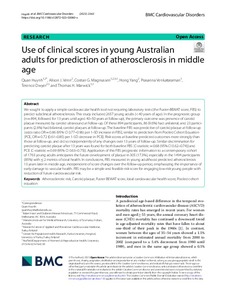Use of clinical scores in young Australian adults for prediction of atherosclerosis in middle age
Huynh Quan; Venn Alison J.; Magnussen Costan G.; Dwyer Terence; Marwick Thomas H.; Venkataraman Prasanna; Yang Hong
https://urn.fi/URN:NBN:fi-fe2023031732169
Tiivistelmä
We sought to apply a simple cardiovascular health tool not requiring laboratory tests (the Fuster-BEWAT score, FBS) to predict subclinical atherosclerosis. This study included 2657 young adults (< 40 years of age). In the prognostic group (n = 894, followed for 13 years until aged 40–50 years at follow-up), the primary outcome was presence of carotid plaque measured by carotid ultrasound at follow-up. Of these 894 participants, 86 (9.6%) had unilateral, and 23 participants (2.6%) had bilateral, carotid plaques at follow-up. The baseline FBS was predictive of carotid plaque at follow-up [odds ratio OR = 0.86 (95% CI 0.77–0.96) per 1-SD increase in FBS], similar to prediction from Pooled Cohort Equation [PCE, OR = 0.72 (0.61–0.85) per 1-SD decrease in PCE]. Risk scores at baseline predicted outcomes more strongly than those at follow-up, and did so independently of any changes over 13 years of follow-up. Similar discrimination for predicting carotid plaque after 13 years was found for both baseline FBS [C-statistic = 0.68 (95% CI 0.62–0.74)] and PCE [C-statistic = 0.69 (95% CI 0.63–0.75)]. Application of this FBS prognostic information to a contemporary cohort of 1763 young adults anticipates the future development of plaque in 305 (17.3%), especially in the 1494 participants (85%) with ≤ 2 metrics of ideal health. In conclusions, FBS measured in young adulthood predicted atherosclerosis 13 years later in middle age, independent of score changes over the follow-up period, emphasizing the importance of early damage to vascular health. FBS may be a simple and feasible risk score for engaging low-risk young people with reduction of future cardiovascular risk.
Kokoelmat
- Rinnakkaistallenteet [19218]
